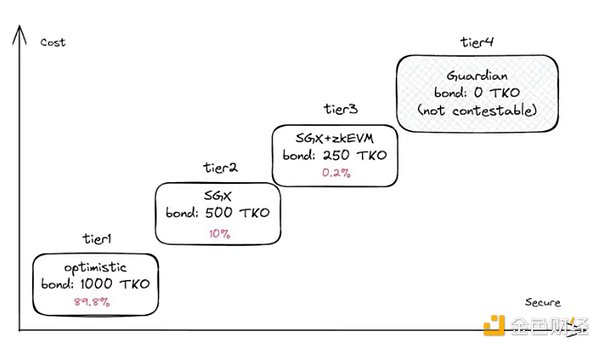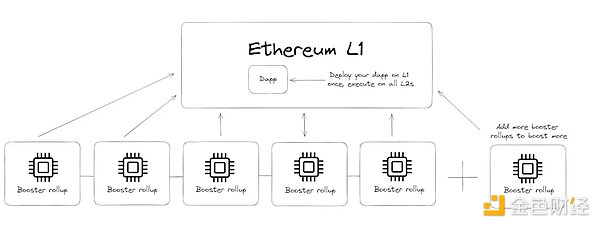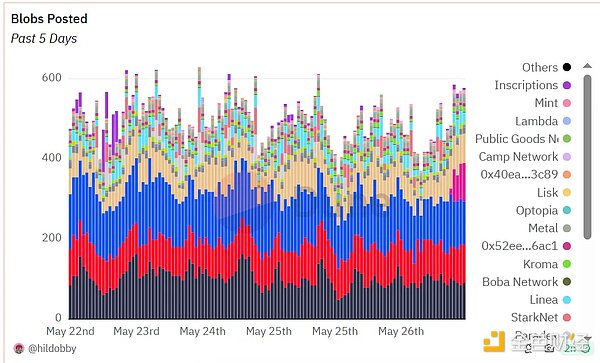Author: LINDABELL Source: chainfeeds
On May 23, Taiko released the first round of airdrop query page, but it set off a wave of debate about fairness in the community. Faced with the response of its founder Daniel Wang, the community did not seem to buy it.
At the same time, on May 25, Ethereum co-founder Vitalik Buterin proposed the first block on the Taiko mainnet as a block proposer, and added a postscript to the block: "I am very happy to see Taiko launched as a Based Rollup platform. Ethereum benefits from L2s with many different approaches. I appreciate that Taiko is one of the first projects to move in this direction."
After the Cancun upgrade, the Ethereum ecosystem has once again put its focus back on the L2 field. Unlike other Rollup projects, Taiko is developing a solution based on Based Rollup, and has attracted the favor of many VCs such as Sequoia China, Generative Ventures, Hashed, Lightspeed Faction, Token Bay Capital and Flow Traders. It makes people curious, compared with other well-known ZK expansion projects, what is special about Taiko? How will its expansion plan affect the L2 ecological pattern?
With these questions, ChainFeeds talked to the Taiko team to discuss Taiko's origin, vision, Ethereum expansion plan and other contents.
Key excerpts:
Daniel Wang, the founder of Taiko, hopes to expand Ethereum without sacrificing decentralization, so that centralized and decentralized second-layer networks can coexist, allowing dApps to make decisions between the two options.
Contestable Rollup is an abstraction of zkRollup and Optimistic Rollup. In the future, if zero-knowledge proofs are cheap enough, Contestable can be configured as a pure zkRollup.
In the process of developing SGX proofs, the Taiko team gradually realized the importance of stateless clients and firmly believed in the feasibility of running stateless clients in zkVM to generate zero-knowledge proofs in the future.
Taiko has been launched on the mainnet, and the submission and proof of blocks are permissionless, but the contract still has an owner. The Taiko team plans to transfer all contracts to Taiko DAO about a year after the mainnet is launched, completely giving up ownership and control of the network.
Taiko Origin: Scaling Ethereum without Sacrificing Decentralization
In 2017, Daniel Wang, the founder of Taiko, created Loopring, the first Ethereum ecosystem DEX protocol built on ZKRollup. But the architecture of Loopring did not fully match Daniel's vision. Daniel hopes to scale Ethereum without sacrificing decentralization, and achieve the coexistence of centralized and decentralized second-layer networks, so that decentralized applications can make smarter decisions between the two options. But Loopring can only be built as a non-programmable second-layer network, lacking a virtual machine structure, and in order to reduce costs, its block generation mechanism is also centralized.
Before founding Taiko, Daniel Wang had many discussions with like-minded developers, focusing mainly on two directions: decentralized social networks or the infrastructure required for decentralized social networks "permissionless second-layer networks." After careful consideration, it is generally believed that it is risky to get involved in the field of decentralized social networks, while the permissionless second-layer network has a greater space for differentiated competition, and Taiko came into being.
Taiko is a Type-1 zkEVM that provides the same opcodes and functions as Ethereum, ensuring high compatibility with the existing Ethereum ecosystem. The Taiko team emphasized that the original design of Taiko was the Based Rollup structure, which makes Ethereum validators ultimately responsible for Taiko's block generation, which realizes the decentralization of proposers. As of now, Taiko has more than 30,000 decentralized proposers and more than 14,000 decentralized validators. In March this year, Taiko completed a $15 million Series A financing led by Lightspeed Faction, Hashed, Generative Ventures, and Token Bay Capital, with a total financing amount of $37 million. In response to the favor of VCs, the Taiko team said that they attach great importance to the strategic synergy between investment institutions and Taiko. In addition to the advantages of Type-1 and fully decentralized architecture, the support of investors is also indispensable for Taiko to become one of the world's largest Discord communities (over 1.07 million members) in a short period of time and attract hundreds of dApps to deploy.
Exploration of Ethereum Rollup Design Framework: BCR and BBR
One of the main differences between Taiko and other Rollups is that it chooses the Based Rollup mechanism, which does not rely on a centralized sorter, but relies on Ethereum validators to sort transactions and blocks. Going further, Taiko co-founder Daniel Wang proposed the concept of "Based Contestable Rollup (BCR)" at the end of 2023. The concept introduces the Contestable mechanism because ZK-EVM code cannot always be error-free, and Taiko is decentralized and has a low fault tolerance, so a cautious attitude needs to be taken.
The Taiko team also elaborated on the main considerations for choosing the Contestable design:
First, Based Rollup does not require permission, and a "higher level of proof" must be introduced to resolve potential bugs in the software. This avoids the need for centralized networks to shut down the network for data error correction. Of course, as the Taiko network runs longer, this error correction mechanism can be gradually removed.
Secondly, although SGX proofs are thousands of times cheaper than zero-knowledge proofs, they are not the most ideal or decentralized way of verification. The Contestable design allows challenges to be raised when doubts arise about SGX proofs, requiring the use of higher-level proofs to re-verify blocks, which reduces costs while increasing the credibility of verification.
Finally, Contestable Rollup is flexible and scalable, and can be seen as an abstraction of zkRollup and Optimistic Rollup. For example, if zero-knowledge proofs are cheaper in the future, we can configure Contestable Rollup as a pure zkRollup, or as a pure Optimistic Rollup according to the needs of the application, so as to adapt to different verification needs.
Daniel Wang also gave a detailed overview of the architecture of Based Contestable Rollup in the article. BCR is a Rollup with dispute characteristics and Based sorting. Under this design, anyone can dispute the state transition in the block, but must pay a dispute deposit in Taiko tokens, and a higher level of proof is required to resolve the dispute in order to verify the block. If the disputant wins, the dispute deposit can be withdrawn and 1/4 of the original prover's validity deposit can be obtained. The new prover will also receive 1/4 of the original prover's validity deposit as a proof fee, and the remaining 1/2 will be confiscated. Vice versa. It is worth noting that in this mechanism, multiple signers jointly act as the upper level in the proof hierarchy in the first few years. As the highest level of proof, in this case, the state transition is considered final and no further questioning is allowed.

In addition, Taiko's BCR architecture also has a core feature that allows each level to use its own proof system. The Taiko team said that under the Contestable Rollup-based architecture, different levels of proof can be constructed, such as the lowest cost Optimistic proof, followed by SGX proof, followed by zkEVM or zkVM proof. These different proof types are the embodiment of the Contestable concept, and these proofs can also be combined to make a hybrid multi-proof system. For example, "SGX+zkVM" can be seen as a more credible proof than using only zkVM proofs.
As the first important milestone, Taiko plans to test the actual operation of BCR on the Alpha-6 testnet Katla, and then launch it on the mainnet. After that, Taiko plans to either upgrade the protocol to Boosted Based Rollup (BBR) or launch an independent BBR second layer as the second important milestone. Taiko said that Boosted Based Rollup is a wise choice to achieve the native scalability of Ethereum. By allowing L1 validators to propose new blocks for the entire network, Ethereum will gain out-of-the-box scalability. For developers, BBR can shard transaction execution and storage. For users, the user experience will be improved because dApps will be distributed on all L2s.

Narrative upgrade: Turning to ZKVM?
Everyone is familiar with zkEVM, but EVM is not designed to run in zero-knowledge circuits, so in practice, implementing zkEVM often requires some trade-offs. Unlike zkEVM, zkVM is a virtual machine implemented as a zero-knowledge proof system circuit. Its advantages include: no need to learn cryptography and ZKP systems, easy to use; universal, Turing-complete ZK-VM can be used as a proof calculation for any calculation; simple, a simple set of constraints is enough to describe the entire VM; able to use recursion, proof verification is just another program executed on the VM.
Taiko has begun to transition from using the zkEVM model to the zkVM model. After switching to the zkVM model, Taiko can modify and run a client to generate ZK proofs. To ensure robustness, Taiko diversifies cryptographic assumptions by building a multi-proof system and contributing to multiple zkVMs (such as RISC Zero, SP1, Powdr), and uses SGX to enhance privacy and security without leaking data.
The Taiko team said that Taiko was one of the first teams to participate in the development of the Ethereum Foundation's PSE zkEVM, and contributed and optimized the code of key circuits such as Keccak and Molke. But in the process, they also realized the limitations of this development model, such as the code is all low-level code, which is difficult to test and verify. And it is not good for novices. With the continuous exploration in the development of SGX proofs, the team began to gradually realize the importance of stateless clients, and under the influence of the progress made by the Risc0 team, they firmly believe in the feasibility of running stateless clients in zkVM to generate zero-knowledge proofs in the future. Taiko has already cooperated with Risc0, and will cooperate with SP1 and more zkVM teams in the future to aggregate these different proof systems through Contestable Rollup, while keeping Taiko's second-layer design fully coupled with each zkVM.
In addition, Taiko was launched on the Ethereum mainnet on the 27th, and has currently processed and released about 15% of the data blocks of the entire Ethereum network. The team emphasized that although the submission and proof of blocks in the Stage1 mainnet mode are permissionless, the contract still has an owner. The team plans to transfer the ownership of the contract to Taiko DAO about a year after the mainnet is launched, completely giving up the ownership and control of the network. The Taiko team also stated that it will invest more resources in the research and development of Preconfirmation, MEV, and Taiko BBR solutions, and hopes to bring more surprises to ecological projects and community users in the future.

Airdrop Storm: Can Taiko still restore community confidence?
Taiko announced the TKO token economics on May 23, announcing that 5% of the initial token supply will be used for the Genesis airdrop. According to the official FAQ, there will be 300,000 addresses eligible to claim more than 50 million tokens. Although the move is intended to give back to the community, it has sparked a wave of controversy about whether the airdrop is fair. Some community members reported that the number of airdrops received was lower than expected, and some users said they participated in related tasks but did not receive airdrops.
Faced with the dissatisfaction of community members, Taiko co-founder Daniel Wang also responded, saying that Taiko's goal is fairness, but it cannot satisfy everyone, and apologized to users who did not receive TKO. But the community did not seem to buy his remarks. Later, Daniel Wang responded again in the Discord community and said that if no airdrops were received, it was because others had more points. As for the opacity of the airdrop rules, it is because transparency cannot resolve differences, and the definition of "fairness" is highly subjective. This remark once again pushed Taiko to the center of public opinion, and some community members called for a boycott of Taiko. However, it is not new for the community to question airdrops. This has happened to projects that have recently released airdrops. Especially when airdrop order brushing has become an industry and involves the participation of a large number of professional teams, they have also become part of the ecosystem, and the community's public opinion may also be affected by these teams. In the future, Taiko also plans to conduct two rounds of airdrops.
 JinseFinance
JinseFinance
 JinseFinance
JinseFinance JinseFinance
JinseFinance JinseFinance
JinseFinance JinseFinance
JinseFinance JinseFinance
JinseFinance JinseFinance
JinseFinance Xu Lin
Xu Lin Finbold
Finbold Finbold
Finbold Cointelegraph
Cointelegraph